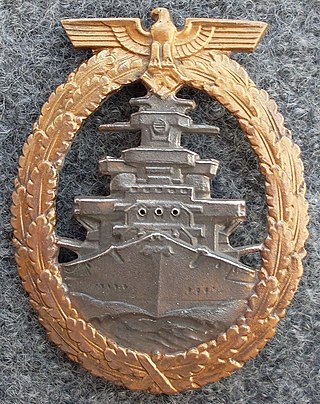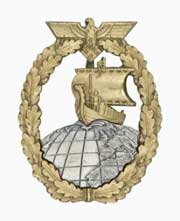
The Kriegsmarine was the navy of Nazi Germany from 1935 to 1945. It superseded the Imperial German Navy of the German Empire (1871–1918) and the inter-war Reichsmarine (1919–1935) of the Weimar Republic. The Kriegsmarine was one of three official branches, along with the Heer and the Luftwaffe, of the Wehrmacht, the German armed forces from 1935 to 1945.

The Reichsmarine was the name of the German Navy during the Weimar Republic and first two years of Nazi Germany. It was the naval branch of the Reichswehr, existing from 1919 to 1935. In 1935, it became known as the Kriegsmarine, a branch of the Wehrmacht; a change implemented by Adolf Hitler. Many of the administrative and organizational tenets of the Reichsmarine were then carried over into the organization of the Kriegsmarine.

Erich Johann Albert Raeder was a German admiral who played a major role in the naval history of World War II, and was convicted of war crimes after the war. Raeder attained the highest possible naval rank, that of grand admiral, in 1939, becoming the first person to hold that rank since Henning von Holtzendorff in 1918. Raeder led the Kriegsmarine for the first half of the war; he resigned in January 1943 and was replaced by Karl Dönitz. At the Nuremberg trials he was sentenced to life imprisonment but was released early owing to failing health.

The Battle of the Atlantic, the longest continuous military campaign in World War II, ran from 1939 to the defeat of Nazi Germany in 1945, covering a major part of the naval history of World War II. At its core was the Allied naval blockade of Germany, announced the day after the declaration of war, and Germany's subsequent counter-blockade. The campaign peaked from mid-1940 through to the end of 1943.

Bernhard Rogge was a German naval officer who, during World War II, commanded a merchant raider. Later, he became a Konteradmiral in West Germany's navy.

The Soviet Navy was the naval warfare uniform service branch of the Soviet Armed Forces. Often referred to as the Red Fleet, the Soviet Navy made up a large part of the Soviet Union's strategic planning in the event of a conflict with the opposing superpower, the United States, during the Cold War (1945–1991). The Soviet Navy played a large role during the Cold War, either confronting the North Atlantic Treaty Organization in western Europe or power projection to maintain its sphere of influence in eastern Europe.

The High Seas Fleet Badge, also known as High Seas Fleet War Badge, was a World War II German military decoration awarded for service to the crews of the Kriegsmarine High Seas Fleet, mainly of the battleships and cruisers, but also those ships that supported them operationally for which there was no other award given. Although the award was instituted in April 1941, it could be awarded for actions that took place prior to this date. It was "primarily in recognition of the sea struggle" against the British fleet.

The Baltic Sea campaigns were conducted by Axis and Allied naval forces in the Baltic Sea, the Gulf of Bothnia, the Gulf of Finland and the connected lakes Ladoga and Onega on the Eastern Front of World War II. After early fighting between Polish and German forces, the main combatants were the Kriegsmarine and the Soviet Navy, with Finland supporting the Germans until 1944 and the Soviets thereafter. The Swedish Navy and merchant fleet played important roles, and the British Royal Navy planned Operation Catherine for control of the Baltic Sea and its exit choke point into the North Sea.

Albrecht Brandi was a German U-boat commander in Nazi Germany's Kriegsmarine during World War II. Together with Wolfgang Lüth, he was the only Kriegsmarine sailor who was awarded with the Knight's Cross of the Iron Cross with Oak Leaves, Swords and Diamonds. The Knight's Cross, and its variants were the highest awards in the military and paramilitary forces of Nazi Germany during World War II. Brandi is credited with the sinking of eight merchant ships for a total of 25,879 gross register tons (GRT), one auxiliary warship of 810 GRT, and three warships of 5,000 long tons.

The U-boat Front Clasp or U-boat Combat Clasp, was a World War II German Kriegsmarine military decoration awarded to holders of the U-boat War Badge to recognize continued combat service and valor.
Vorpostenboot, also referred to as VP-Boats, flakships or outpost boats, were German patrol boats which served during both World Wars. They were used around coastal areas and in coastal operations, and were tasked with – among other things – coastal patrol, ship escort, and naval combat.
The Black Sea Campaigns were the operations of the Axis and Soviet naval forces in the Black Sea and its coastal regions during World War II between 1941 and 1944, including in support of the land forces.

Wilhelm Meisel was an Admiral of the Kriegsmarine of Nazi Germany during World War II and a recipient of the Knight's Cross of the Iron Cross.
The Honour Roll Clasp was a decoration of Nazi Germany during World War II. There were different versions for the Army (Heer), Air Force (Luftwaffe) and Navy (Kriegsmarine).

The Minesweeper War Badge or Minesweepers, Sub-Chasers and Escort-Vessel War Badge was a World War II German military decoration awarded to Kriegsmarine members for service on minesweepers vessels. The award was instituted on 31 August 1940 by Grand Admiral Erich Raeder. It was first awarded on 28 November 1940.

The Auxiliary Cruiser War Badge was a World War II German military decoration awarded to officers and men of the Kriegsmarine for service on Auxiliary Cruisers or the supply ships that supported them for a successful large voyage. The award was instituted on 24 April 1941 by Grand Admiral Erich Raeder.

United States Navy operations during World War I began on April 6, 1917, after the formal declaration of war on the German Empire. The United States Navy focused on countering enemy U-boats in the Atlantic Ocean and the Mediterranean Sea while convoying men and supplies to France and Italy. Because of United States's late entry into the war, her capital ships never engaged the German fleet and few decisive submarine actions occurred.
The action of 13 May 1942 was a naval engagement during World War II between the British Royal Navy and the German Kriegsmarine. It was an attempt by Royal Navy Motor Torpedo Boats (MTBs) to stop the German auxiliary cruiser Stier from reaching Gironde, France. Stier made it through the English Channel and reached Gironde, but MTBs sunk the German fleet torpedo boats Iltis and Seeadler. MTB 220 was sunk by the German ships.

Surface flotillas of the Kriegsmarine were organizational groupings of German naval vessels during World War II based on class of vessel and geographical location. Surface flotillas were not operationally deployed units, but functioned through the administrative command chain of the Kriegsmarine.
A type commander in the Kriegsmarine was a permanently assigned administrative officer in the organization of the Kriegsmarine which oversaw the development, deployment, and in some cases operational activities of the various classes of German naval vessels. Due to cross jurisdiction with the Navy group commanders, who tactically commanded all vessels at sea, some type commanders were little more than ceremonial officers who held a title with little authority. Others, such as Karl Dönitz who commanded the German U-boat force, exercised near total independence and held enormous authority, both operationally and administrative.

























